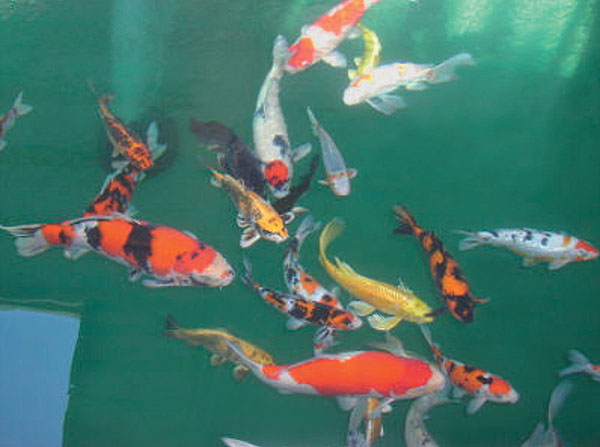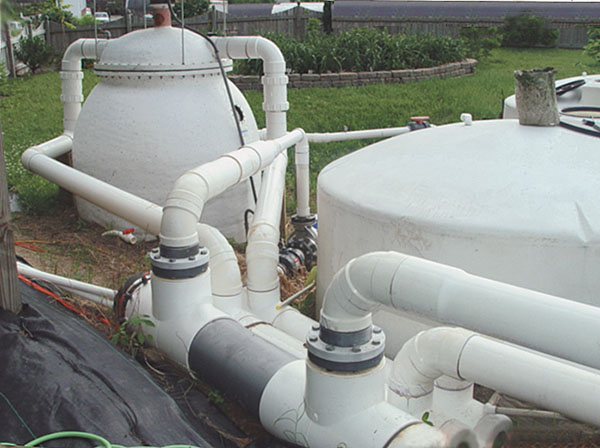Only stringent biosecurity measures can help prevent disease outbreaks

Representing more than 90 percent of all finfish aquaculture harvests, various species of carp dominate world finfish aquaculture. Carp culture in the United States, however, focuses predominately on ornamental koi. Koi carp (Cyprinus carpio) are the stars of 100 koi hobbyist clubs across the country. Individual koi can have a market value of tens of thousands of dollars. Annual U.S. koi sales have been estimated at about $4 million.
Goldfish, another popular ornamental carp species, have a lower economic value than koi, but are frequent household and pond pets in the United States. The total annual value of U.S. farm sales of carp is near $21 million, and in 2001, U.S. carp exports were valued at $1.8 million.
The presence of viral pathogens at carp farms could of course limit these exports. Although several viruses infect carp, spring viremia of carp virus (SVCV) and koi herpes virus (KHV) are two major viruses associated with catastrophic losses of carp.
Spring viremia of carp virus
Spring viremia is a disease of koi and other cyprinids like goldfish and common carp caused by a rhabdo-virus similar to rabies virus in humans. Reportable to the Office International des Epizooties (OIE, a world organization for animal health), spring viremia is a systemic, wasting disease that results in suffering, morbidity, and mortality in carp.
The virus was first isolated in 1971 from fish with clinical signs of abdominal swelling and petechial hemorrhages on the skin. Other clinical signs often exhibited include protruding eyes, distended abdomen, and inflamed anus. SVCV is seasonal, with incidences mainly at water temperatures of 18 to 20 degrees-C. At higher temperatures, fish clear the virus efficiently.
Prior to 2002, SVCV was considered a foreign animal disease in the U.S. However, in 2002, spring viremia was diagnosed in koi grown in ponds at a hatchery in North Carolina. In subsequent studies near that hatchery, and in Virginia and later Wisconsin, serologic surveys documented the presence of the virus in free-ranging cyprinids. This year, SVCV was reported in the states of Washington, Minnesota, and Missouri.
OIE-recommended methods of SVCV diagnosis are virus isolation, enzyme-linked immunosorbent assay and direct immunofluorescence. Currently there is no treatment for spring viremia. Farms with infected koi or other species of carp are depopulated.
Koi herpes virus
KHV is a viral disease that affects only koi and common carp. It was first isolated from koi in the U.S. and Israel in 1988. Since that time, it has also been found in fish from eastern European countries, South Africa, Indonesia, Japan and Canada. The virus has spread rapidly to many regions of the world, most likely due to the wide international trade of koi.
The clinical signs associated with this disease include pale patches on animals’ gills, bodies or fins. Typically, only sudden mass mortality of 70-100 percent from KHV is noticed.
Although the actual cause of death is unknown in these cases, it is hypothesized that the virus damages the epithelial cells of multiple organs and the fish succumb to organ failure. Another possibility is the virus compromises the immunity of the fish, leaving them prone to bacterial or parasitic invasion.
KHV mortality is seasonal and occurs when water temperature is 18 to 25 degrees-C. The recommended protocol for diagnosis of KHV is virus isolation and a polymerase chain reaction assay on liver, kidney, spleen, gill, or gastrointestinal tissue.
There is no proven treatment for KHV, although researchers in Israel have shown that raising the water temperature to 28 degrees-C may decrease mortality. However, this practice should be discouraged since it may lead to fish that serve as carriers of the virus and cause further incidences of the disease. The Israeli group has also produced a vaccine for KHV, but it is not likely to become commercially available. Live attenuated vaccines like this one have a risk of the virus reverting to a form that causes mortality.
Preventive measures

Since there are no treatments or vaccines for KHV or SVCV, the best method of protection is prevention and adherence to proper biosecurity measures. When new fish are brought to a facility, they should be quarantined for at least 30 days and held in water of 15 to 22 degrees-C to induce disease if the viruses are present.
All equipment such as nets, boots, and water quality measuring devices should be disinfected between tanks. Proper disinfectants include chlorine bleach at 500 to 5,000 mg free chlorine per liter, 0.1 to 0.2 percent quaternary ammonium compounds, alcohols of 70 percent concentration, or iodophor compounds at 30 to 50 mg free iodine per liter.
Although chlorine is the most effective disinfectant, it destroys netting and may harm fish if not completely rinsed from equipment. If multiple buildings house fish at a facility, disposable shoe covers or boots that can be disinfected between buildings should be worn when entering each building. When handling fish, it is important to wash hands between each tank.
To protect fish from diseases in the wild, any well, river, or reservoir water that is used should be treated prior to use. Although the technique has not been fully validated, the U.S. Department of Agriculture’s Animal and Plant Health Inspection Service recommends that sand filtration and ultraviolet disinfection of surface water may eliminate the risk of SVCV outbreaks. When mass mortality of fish is experienced due to unknown causes, a veterinarian should be consulted or samples sent to a diagnostic laboratory for evaluation.
Conclusion
SVCV and KHV are the most devastating viral pathogens of carp. Since no large-scale studies have investigated the prevalence of these diseases in wild populations of carp, the risk of the diseases spreading to hobbyists’ ponds or aquaculturists’ farms from wild fish is unknown.
With the amount of trade volume in this industry, it is essential that hobbyists and aquaculturists protect their stocks from diseases that may be harbored by incoming fish. Since there are no efficient therapies for SVCV or KHV, only stringent biosecurity measures can help prevent disease outbreaks and control the spread of these viruses.
(Editor’s Note: This article was originally published in the October 2004 print edition of the Global Aquaculture Advocate.)
Now that you've finished reading the article ...
… we hope you’ll consider supporting our mission to document the evolution of the global aquaculture industry and share our vast network of contributors’ expansive knowledge every week.
By becoming a Global Seafood Alliance member, you’re ensuring that all of the pre-competitive work we do through member benefits, resources and events can continue. Individual membership costs just $50 a year. GSA individual and corporate members receive complimentary access to a series of GOAL virtual events beginning in April. Join now.
Not a GSA member? Join us.
Authors
-
Raghunath Shivappa, Ph.D.
Aquatic Animal Epidemiology and Conservation Genomics Laboratory
Department of Population Health and Pathobiology
North Carolina State University
College of Veterinary Medicine
4700 Hillsborough Street
Raleigh, North Carolina 27606 USA -
Shannon Kozlowicz, DVM
Aquatic Animal Epidemiology and Conservation Genomics Laboratory
Department of Population Health and Pathobiology
North Carolina State University
College of Veterinary Medicine
4700 Hillsborough Street
Raleigh, North Carolina 27606 USA -
Jay Levine, DVM, MPH
Aquatic Animal Epidemiology and Conservation Genomics Laboratory
Department of Population Health and Pathobiology
North Carolina State University
College of Veterinary Medicine
4700 Hillsborough Street
Raleigh, North Carolina 27606 USA
Tagged With
Related Posts

Health & Welfare
Candidate gene markers for selective breeding of CyHV-3-resistant carp, koi
Common carp and koi producers around the world have suffered substantial financial losses due to a contagious disease caused by cyprinid herpesvirus-3.

Intelligence
An engineer’s design for a classroom aquaculture-aquaponics system
An aquaponics teaching system was designed, built and operated by students at the University of Arizona, integrating its operation and management into the educational curriculum. This engineering design will require minimum maintenance and will last years.

Health & Welfare
Snail control in fish ponds
The freshwater drum is a proposed snail-control vector in catfish ponds. In tank studies the drum showed high survival and reduced snail populations.

Aquafeeds
Strategies for reducing feed costs in small-scale aquaculture
Facing rising aquafeed costs, researchers and farmers are investigating ways to lessen resources spent on feeds by feeding less and feeding differently at small-scale aquaculture operations.


